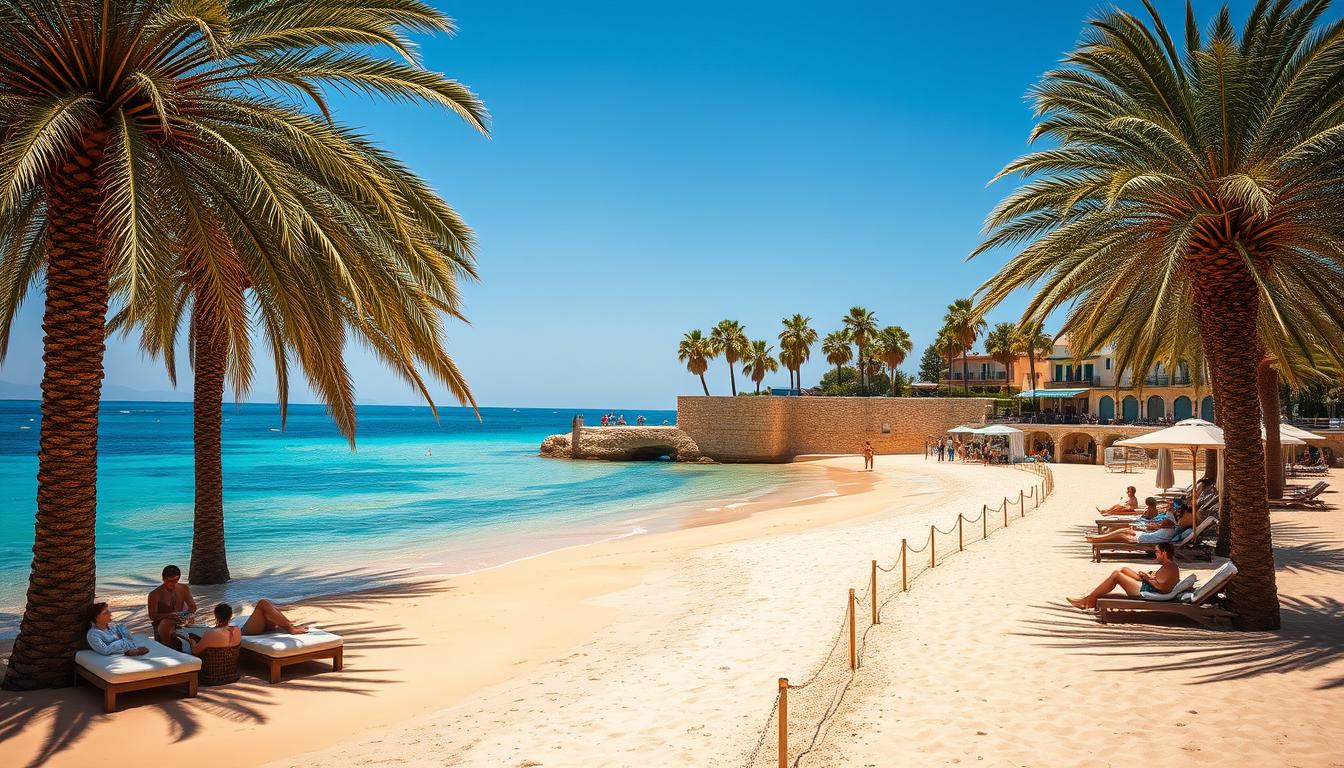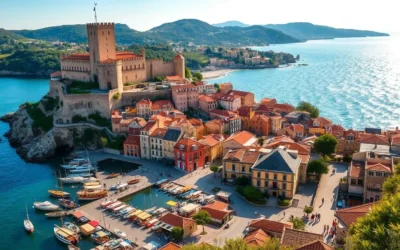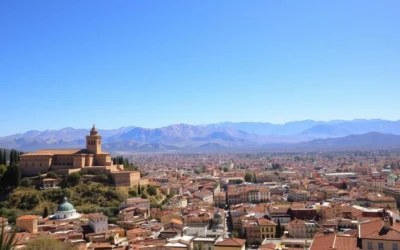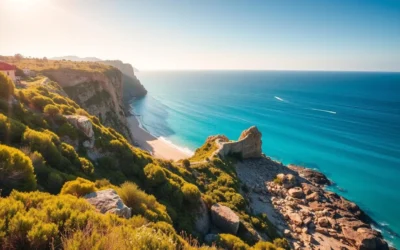✓ Accommodations ✓ Flights ✓ Rental Cars ✓ Tours & Activities
Did you know that the Balearic Islands enjoy over 300 days of sunshine each year? This Mediterranean gem is a paradise for travelers seeking warm weather and stunning landscapes. Whether you’re dreaming of sunny beach days or exploring charming towns, this destination has something for everyone.
Summer is the most popular time to visit, with temperatures perfect for soaking up the sun. However, the islands also offer mild winters, making them a great choice for off-peak travel. Understanding the seasonal changes can help you plan the perfect trip.
This guide will help you choose the ideal month to visit based on your weather preferences. From bustling summer vibes to quieter winter escapes, you’ll discover how to make the most of your journey. Let’s dive into what makes this destination a year-round favorite.
Introduction to the Balearic Islands Weather
The Mediterranean climate of this destination ensures warm summers and mild winters, perfect for year-round travel. This unique weather pattern shapes the experience of every traveler, making it essential to understand how it influences your plans.
Overview of the Mediterranean Climate
This region enjoys long, sunny days with temperatures that rarely dip too low. Summers are hot and dry, while winters remain mild and comfortable. These conditions make it a haven for outdoor enthusiasts and those seeking relaxation.
Seasonal shifts bring variety, from blooming springs to golden autumns. Knowing these patterns helps you choose the best time visit based on your preferences.
Why Weather Matters for Your Trip
Weather plays a crucial role in shaping your itinerary. Sunny days are perfect for beach outings, while cooler temperatures are ideal for exploring towns and nature trails. Planning around the best time ensures you make the most of your visit.
Here’s why weather should be a top consideration:
- It determines the activities you can enjoy, from swimming to hiking.
- It affects your packing list, ensuring you’re prepared for the conditions.
- It influences crowd levels, helping you avoid peak tourist seasons.
By understanding the climate, you can tailor your trip for an unforgettable experience.
Understanding the Mediterranean Climate and Local Variations
Wind, rainfall, and sunlight play a significant role in shaping the local climate. These natural elements create diverse weather patterns across the islands, making each area unique. Understanding these influences helps you plan your time visit more effectively.
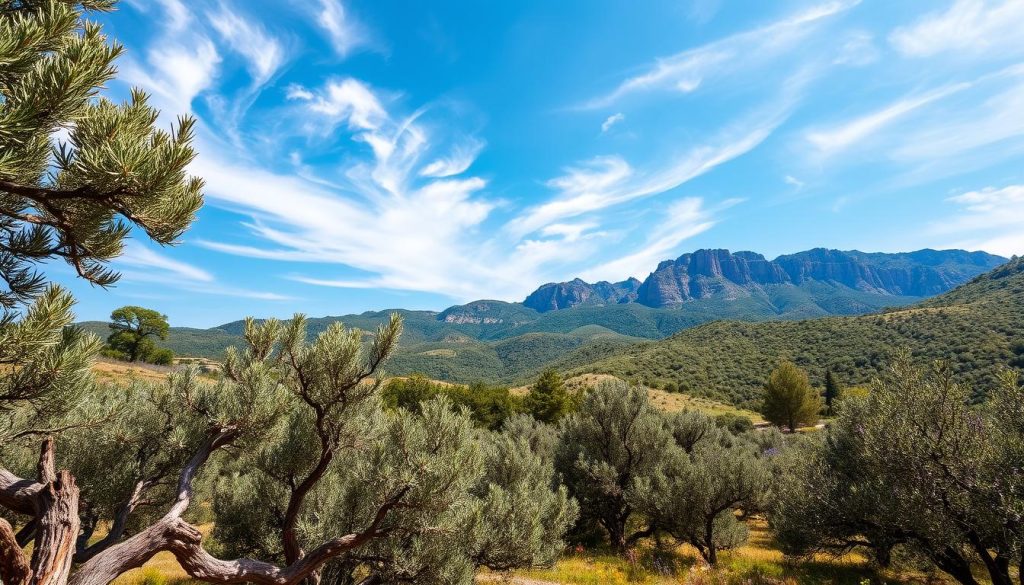
Climate Influences: Wind, Rainfall, and Sunlight
Wind patterns, like the Tramuntana, can bring cooler air or sudden gusts, especially in mountainous areas. Rainfall varies significantly, with some months being drier than others. Sunlight intensity also differs, affecting the time of year you might prefer for outdoor activities.
Here’s how these elements impact your trip:
- Windy conditions are ideal for water sports but may affect beach days.
- Rainfall is minimal in summer but increases in autumn, offering lush landscapes.
- Sunlight intensity peaks in summer, perfect for sunbathing but requiring extra protection.
The Impact of Geography on Weather
Geography plays a key role in creating microclimates. The Tramuntana mountains, for example, bring cooler temperatures and occasional snow in winter. Coastal areas enjoy milder weather, while inland regions can experience more extreme conditions.
Here’s a comparison of how geography affects different islands:
| Island | Key Feature | Weather Impact |
|---|---|---|
| Mallorca | Tramuntana Mountains | Cooler temperatures, occasional snow |
| Menorca | Flat terrain | Mild, consistent weather |
| Ibiza | Coastal protection | Less wind, warmer temperatures |
| Formentera | Low elevation | Hot summers, mild winters |
By understanding these variations, you can choose the best time visit based on your preferred activities and comfort level.
Seasonal Breakdown: Spring, Summer, Autumn, and Winter
Each season brings its own unique charm to this Mediterranean paradise, offering something special for every traveler. Whether you prefer the blooming beauty of spring or the golden hues of autumn, there’s a perfect time year for your visit.
Spring: Pleasant Beginnings and Early Warmth
Spring is a magical time year to explore this destination. With average temperatures ranging from the low to mid-70s, the weather is ideal for outdoor activities. March starts with mild days, while May brings warmer afternoons perfect for beach strolls.
Rainfall is minimal during spring, making it a great time for hiking and sightseeing. The landscapes come alive with vibrant flowers, and the crowds are smaller compared to summer. Local festivals also begin to pop up, offering a glimpse into the region’s culture.
Autumn: Mild Temperatures and Natural Beauty
Autumn is another fantastic time year to visit. The temperatures are mild, averaging in the mid-70s, and the summer crowds have thinned out. September and October bring sporadic rain, but the lush landscapes are worth it.
This season is perfect for exploring nature trails or enjoying the serene beaches. Autumn also hosts several festivals, celebrating everything from local harvests to traditional music. It’s a quieter yet equally enchanting experience.
| Season | Average Temperature | Rainfall | Key Highlights |
|---|---|---|---|
| Spring | Low to mid-70s°F | Minimal | Blooming landscapes, fewer crowds, local festivals |
| Autumn | Mid-70s°F | Sporadic | Lush scenery, mild weather, cultural festivals |
Balearic Islands, Spain: Best Months for a Weather-Savvy Trip – Expert Analysis
Choosing the right time to visit can make or break your travel experience. Understanding the differences between peak and shoulder seasons is key to planning a memorable trip. This expert analysis will help you decide when to go based on weather, costs, and crowd levels.
Comparing Peak and Shoulder Seasons
Peak season, typically in summer, attracts the most visitors. The weather is warm, and the beaches are bustling. However, this also means higher accommodation rates and crowded attractions. Shoulder seasons, like spring and autumn, offer a more relaxed experience.
Here’s why shoulder seasons might be the better choice:
- Weather consistency: Mild temperatures make outdoor activities enjoyable.
- Lower costs: Accommodation and flights are often cheaper.
- Fewer crowds: You’ll have more space to explore popular places.
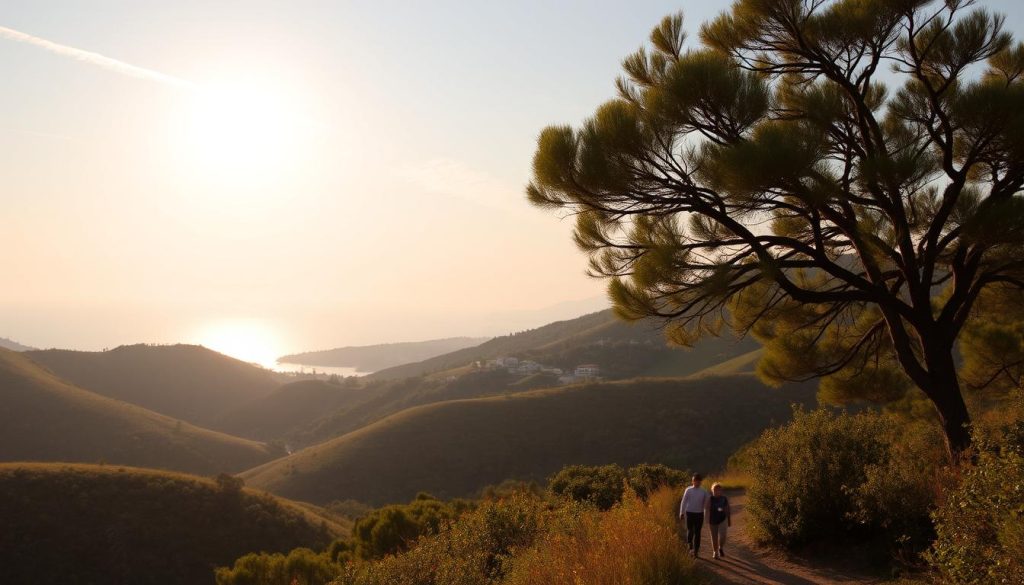
Experts recommend shoulder seasons for a balanced experience. As one travel analyst noted,
“Traveling during off-peak months allows you to enjoy the destination without the stress of large crowds.”
Here’s a quick comparison of peak vs. shoulder seasons:
| Aspect | Peak Season | Shoulder Season |
|---|---|---|
| Weather | Hot and dry | Mild and pleasant |
| Costs | High | Lower |
| Crowds | Heavy | Light |
Whether you prefer the lively atmosphere of summer or the tranquility of spring and autumn, understanding these differences ensures you pick the best season for your trip.
Insider Tips on Packing and What to Expect
Packing smart for your trip ensures you’re ready for any weather surprises. The climate in this region can vary, so being prepared is key to enjoying your year visit to the fullest. Whether you’re visiting in spring, summer, or autumn, these tips will help you pack efficiently.
What to Pack for Changing Temperatures
Layering is your best friend when dealing with fluctuating climate conditions. During spring, pack light jackets for cooler mornings and evenings. Summer calls for breathable fabrics like cotton and linen to stay comfortable in the heat.
For autumn, bring a mix of light and warm clothing to adapt to sporadic rain and mild days. Winter travelers should include sweaters and a waterproof jacket for cooler evenings. Always check the forecast for your specific region to tailor your packing list.
Local Advice on Attire and Essentials
Locals recommend dressing comfortably while respecting the laid-back vibe of the region. Light, casual attire is perfect for daytime exploring, while slightly dressier options work for evening outings. Don’t forget essentials like sunscreen, a reusable water bottle, and sturdy walking shoes.
Here are some insider tips to keep in mind:
- Pack a scarf or shawl for cooler evenings or breezy days.
- Bring a compact umbrella or rain jacket for unexpected showers.
- Include a swimsuit year-round, as many hotels have heated pools.
By following these suggestions, you’ll be well-prepared for your year visit, no matter the season or region you explore.
Special Events and Festivals to Enhance Your Visit
Immerse yourself in the vibrant culture of this Mediterranean destination by timing your visit with its lively festivals. These events offer a lot of local flavor and authentic experiences, making them a highlight of any trip.

Local Festivals and Cultural Celebrations
From traditional parades to lively music performances, the festivals here are deeply rooted in the region’s heritage. Many events are tied to seasonal changes, offering a unique way to experience the time year visit.
For example, Semana Santa features daily processions with elaborate floats and costumes. La Tomatina, held on the last Wednesday of August, is a fun and messy celebration that attracts thousands. These events provide a lot of opportunities to connect with the local culture.
Timing Your Trip to Experience Unique Events
Planning your time year visit around these festivals can make your trip even more memorable. Spring and autumn are particularly rich in cultural events, offering a balance of pleasant weather and fewer crowds.
Here are some tips to help you align your travel dates with the best festivals:
- Check the festival calendar to find events that match your interests.
- Book accommodations early, as popular festivals can fill up quickly.
- Be prepared for a lot of activity on festival days, with streets bustling with energy.
Whether you’re drawn to the music of Las Fallas or the history of Moors & Christians Festivals, these events add a special touch to your journey.
Enjoying Outdoor Activities Across the Islands
Spring brings ideal conditions for outdoor adventures, with fewer crowds and pleasant weather. Whether you’re drawn to the beach or the trails, this season offers the perfect balance of warmth and tranquility. From water sports to nature walks, there’s something for every traveler to enjoy.
Beach Experiences and Water Sports
The islands’ pristine beaches are a haven for relaxation and adventure. During spring, the weather is warm enough for swimming, but the crowds are still light. Try your hand at paddleboarding, kayaking, or snorkeling to explore the crystal-clear waters. Many beaches also offer equipment rentals, making it easy to dive into your favorite activities.
Hiking, Cycling, and Nature Walks
For those who prefer land-based adventures, spring is the best time for hiking and cycling. The mild temperatures and blooming landscapes create a picturesque backdrop for exploring scenic trails. Popular routes include coastal paths and mountain trails, offering breathtaking views at every turn.
Here’s a quick guide to some of the best outdoor activities:
| Activity | Best Location | Why It’s Great in Spring |
|---|---|---|
| Hiking | Mountain Trails | Cooler temperatures, fewer visitors |
| Cycling | Coastal Routes | Flat terrain, scenic views |
| Nature Walks | Forest Reserves | Lush greenery, peaceful atmosphere |
Whether you’re a seasoned adventurer or a casual explorer, these activities promise unforgettable experiences. Pack your gear and get ready to make the most of the great outdoors!
Comparing the Regional Variations: Mallorca, Menorca, Ibiza, and Formentera
Each island in this Mediterranean archipelago offers distinct weather and attractions, making it essential to compare them before your visit. From Mallorca’s diverse terrain to Ibiza’s sheltered bays, understanding these differences ensures you pick the perfect destination for your trip.
Mallorca’s Diverse Climate and Attractions
Mallorca’s varied geography creates a range of microclimates, from the cooler Tramuntana mountains to the warmer coastal areas. This diversity allows for a wide array of activities, whether you’re hiking in the mountains or relaxing on one of its 200 beaches.
The island’s weather also influences its event calendar. Spring and autumn are ideal for cultural festivals, while summer is perfect for beach parties. Rainfall is minimal during peak tourist months, ensuring you can enjoy outdoor activities without interruption.

Ibiza’s Mild Weather and Wind Protection
Ibiza is known for its mild weather and natural wind protection, making it a favorite for travelers seeking a home-away-from-home feel. The island’s sheltered bays and consistent temperatures create a comfortable environment year-round.
Unlike other islands, Ibiza experiences less rain, especially during summer. This makes it ideal for outdoor events like music festivals and beach gatherings. The island’s unique geography also protects it from strong winds, ensuring a pleasant stay.
| Island | Key Feature | Weather Impact | Best For |
|---|---|---|---|
| Mallorca | Diverse terrain | Varied microclimates | Hiking, cultural events |
| Menorca | Higher rainfall in autumn | Lush landscapes | Nature walks, quiet retreats |
| Ibiza | Sheltered bays | Mild, less windy | Festivals, beach activities |
| Formentera | Low elevation | Hot summers, mild winters | Cycling, serene beaches |
By understanding these regional variations, you can choose the island that best suits your travel preferences. Whether you’re drawn to Mallorca’s diverse activities or Ibiza’s laid-back vibe, each destination offers a unique experience.
Travel Logistics and Planning Tips for the U.S. Traveler
Planning a trip to a Mediterranean destination? Here’s how to make it seamless. From booking transportation to finding the best deals, these tips will help you navigate your journey with ease. Whether you’re traveling solo or with family, a little preparation goes a long way.
Booking Transportation and Accommodation
Securing your travel arrangements early can save you time and money. Flights to the region are often cheaper during the shoulder seasons, like spring and autumn. Consider using comparison tools to find the best rates.
For accommodations, look beyond hotels. Vacation rentals and boutique stays often offer better value. Many properties also include perks like free breakfast or access to local wine tastings. Booking directly with the provider can sometimes unlock additional discounts.
Cost Considerations and Budget Travel Tips
Traveling during off-peak months can significantly reduce costs. Flights, hotels, and even local activities are often more affordable. If you’re on a tight budget, prioritize experiences that offer the most value, like free walking tours or local music festivals.
Here are some practical ways to stretch your budget:
- Use public transportation instead of taxis.
- Dine at local markets or smaller eateries for authentic and affordable meals.
- Take advantage of city cards that bundle attractions and transit passes.
For a unique experience, consider a course in local cuisine or crafts. These activities often provide a deeper connection to the culture without breaking the bank.
By planning ahead and making smart choices, you can enjoy a memorable trip without overspending. Whether it’s savoring a glass of wine at a vineyard or dancing to live music at a festival, these tips ensure you make the most of your adventure.
Conclusion
Planning your next getaway? Timing is everything when it comes to enjoying the perfect weather and avoiding crowds. By choosing the right way to balance your travel dates, you can experience the best of both worlds—pleasant temperatures and fewer visitors.
Whether you prefer the warmth of the day or the coolness of the night, understanding seasonal variations ensures a comfortable trip. From sunny afternoons to starry evenings, every moment offers a unique view of this stunning destination.
Take these tips to heart as you plan your adventure. With the right preparation, you’ll create memories that last a lifetime. Start packing and get ready to explore!
The above is subject to change.
Check back often to TRAVEL.COM for the latest travel tips and deals.
